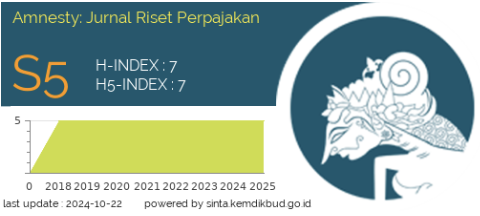Tax Planning Strategies for Tax Saving at PT Ramayana Lestari Sentosa, Tbk
Abstract
Keywords
Full Text:
PDFReferences
Astuti, W. A., & Nafis, S. N. (2024). Strategi Cerdas di Pasar Properti Indonesia: Penghindaran Pajak, Keuntungan, dan Persediaan. Jurnal Riset Akuntansi Vol. 16, No. 1, 11-22.
Direktorat Jenderal Pajak. (2022). pajak.go.id. From Fungsi Pajak: https://pajak.go.id/id/fungsi-pajak
Indonesia. (2008). Undang-Undang Republik Indonesia Nomor 36 Tahun 2008 tentang Perubahan Keempat atas Undang-Undang Nomor 7 Tahun 1983 tentang Pajak Penghasilan. Jakarta: Sekretariat Negara.
Mangoting, Y. (1999). Tax Planning: Sebuah Pengantar Sebagai Alternatif Meminimalkan Pajak. Jurnal Akuntansi dan Keuangan Vol. 1, No. 1, 43-53.
PT Ramayana Lestari Sentosa, Tbk. (2023). Annual Report 2023. Jakarta.
Pusparini, I. A., AR, M. D., & Azizah, D. F. (2013). Implementasi Tax Planning dalam Upaya Penghematan Pajak Penghasilan (PPh) Badan (Studi Kasus Pada PT. Citra Perdana Kendedes Malang). Jurnal Administrasi Bisnis, Vol. 5, No. 1, 1-9.
Saputra, M. A., & Amalia, M. R. (2022). Strategi Penerapan Perencanaan Pajak (Tax Planning). JABKO: Jurnal Akuntansi dan Bisnis Kontemporer, Vol. 2, No. 2, 163-170.
Tempo. (2024, April 29). Tempo.CO. From Jenis-Jenis Sumber Penerimaan Negara Indonesia, Mana yang Terbesar?: https://www.tempo.co/ekonomi/jenis-jenis-sumber-penerimaan-negara-Indonesia-mana-yang-terbesar--63709
Zain, M. (2003). Manajemen Perpajakan. Bandung: Salemba Empat.
DOI: https://doi.org/10.26618/jrp.v8i1.17045
Refbacks
- There are currently no refbacks.

This work is licensed under a Creative Commons Attribution-NonCommercial-NoDerivatives 4.0 International License.
View My Stats




12.jpg)